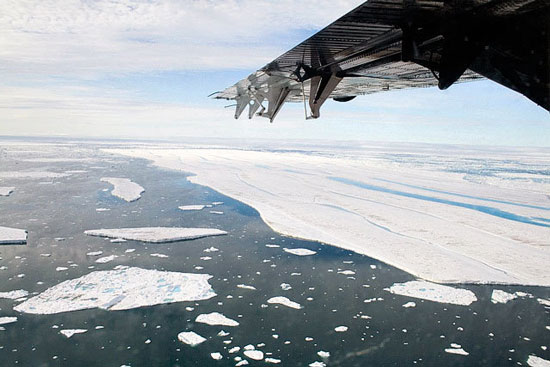The real cause of ice melting in the North Pole?
The image of cracks on the giant ice sheet in the Arctic is seen as clear evidence of the damage caused by global warming.
>>>The amount of Arctic ice falls a record
However, a group of scientists from Laval University (Canada) discovered that this is not the real cause.
One of the ice shelves may have been broken before, about 1,400 years ago, long before the industry appeared and impacted our planet.

Scientists believe the Ward Hunt ribbon
had broken about 1,400 years ago. (Photo: AP)
By studying sediment materials at the bottom of Disraeli Fjord lake in Canada, they believe the Ward Hunt ribbon is located on Ellesmere Island's northern coast, in Canada's Nunavut territory - the largest remaining ice in the Arctic with The area of 170 square miles was broken and then frozen again 800 years ago.
Tape strips are separated by pressure from glaciers. They act as dams in the fjord and as a result sediments appear at the boundary between fresh water from ice sheets and saltwater from the ocean.
The team used dating methods thanks to carbon radioactivity and many other techniques to test the sediment, which in turn can simulate events that occur in time.
The results showed that ice sheets appeared 4,000 years ago and existed before the cracked 1,400 years ago. This situation continued until it froze again 800 years ago. Centuries later, about 100 years ago, the iceberg began to shrink and shrink each year.
During the 20th century, the Arctic ice shelves lost more than 90% of the total surface area and are still melting quickly.
This result was published in the Proceedings of the National Academy of Sciences.
- 'The third pole' of the Earth is melting
- The winter is prolonged due to the North Pole spiral moving
- The pole from the North of the Earth is ... shifting
- The north pole from the Earth is moving
- The pole from the North is moving to Russia
- How does the compass tell us where the North pole is at the South Pole?
- Video: Earth has 3 north poles
- Melting ice makes Norway approach Asia
- Beautiful scenery is unique in the North Pole
- City Ho Chi Minh will be 'submerged' if the 2 pole ice melts
- Canada started drawing seabed maps around the North Pole
- Why did the North Pole move toward London?
 Is the magnetic North Pole shift dangerous to humanity?
Is the magnetic North Pole shift dangerous to humanity? Washington legalizes the recycling of human bodies into fertilizer
Washington legalizes the recycling of human bodies into fertilizer Lightning stone - the mysterious guest
Lightning stone - the mysterious guest Stunned by the mysterious sunset, strange appearance
Stunned by the mysterious sunset, strange appearance Plan to build giant canopy over Antarctica has problems
Plan to build giant canopy over Antarctica has problems  Why does ice stick to your hands when you hold it?
Why does ice stick to your hands when you hold it?  NASA releases ice map on Mars
NASA releases ice map on Mars  After 389 days in the Arctic, costing more than $160 million, hundreds of scientists brought back bad news: What was it?
After 389 days in the Arctic, costing more than $160 million, hundreds of scientists brought back bad news: What was it?  650,000-year-old 'gateway to the underworld' discovered in Siberia
650,000-year-old 'gateway to the underworld' discovered in Siberia  How to explain the strange ice circle that rotates like a time-travel door?
How to explain the strange ice circle that rotates like a time-travel door? 